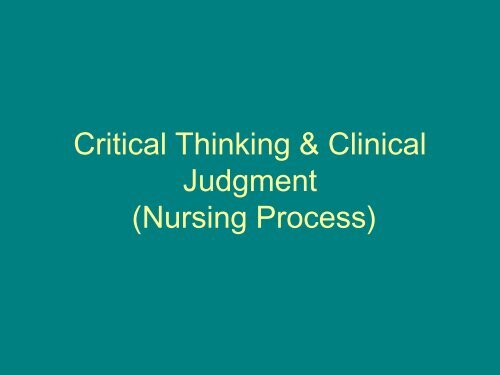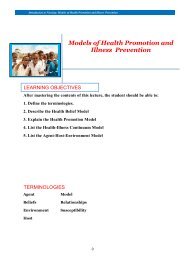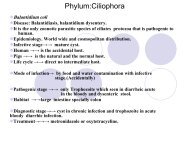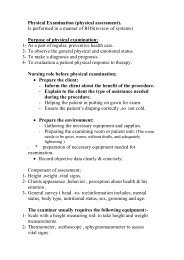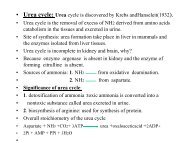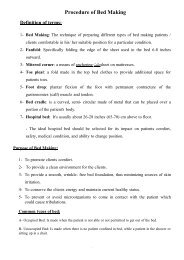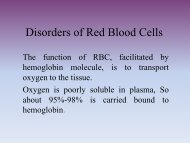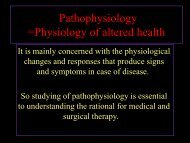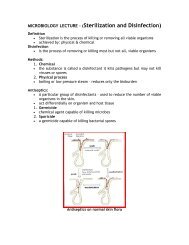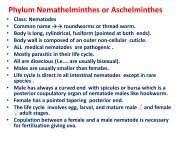Critical Thinking & Clinical Judgment
Critical Thinking & Clinical Judgment
Critical Thinking & Clinical Judgment
Create successful ePaper yourself
Turn your PDF publications into a flip-book with our unique Google optimized e-Paper software.
<strong>Critical</strong> <strong>Thinking</strong> & <strong>Clinical</strong><br />
<strong>Judgment</strong><br />
(Nursing Process)
<strong>Clinical</strong> <strong>Thinking</strong><br />
defined as purposeful, self-regulatory<br />
judgment that gives reasoned and reflective<br />
consideration for evidence contexts,<br />
conceptualization, methods, and criteria<br />
( Facione,1990).
• <strong>Critical</strong> thinking examine all elements of a<br />
situation and think through alternative<br />
strategies to achieve an end.<br />
Specific thinking skills including<br />
• Problem solving<br />
• Decision Making.<br />
• Diagnostic reasoning.<br />
• <strong>Clinical</strong> judgment.
• Problem solving is<br />
Is a process used to arrive at an answer or<br />
solution. Through:<br />
1- defining a problem<br />
2- selecting information pertinent to its<br />
conclusion<br />
3- formulating alternative solution.<br />
4- drawing a conclusion and judging the<br />
validity of the conclusion.
• Decision- making involves choosing<br />
between two or more option as a means to<br />
achieve a desired result.( goal directed or<br />
goals will direct the outcome)<br />
• In the clinical setting yields approaches for<br />
nsg. Care selected from a variety of<br />
possible nsg. Interventions.<br />
• You must decide which intervention will be<br />
most likely to achieve the desired client<br />
outcomes.
<strong>Clinical</strong> judgment:<br />
is a conclusion or an opinion that a<br />
problem or situation requires nursing<br />
determines the cause of the problem,<br />
distinguishes between similar problems, or<br />
discriminates between two or more course<br />
of action.
• Process of thinking<br />
T.H.I.N.K. Model<br />
• Five mode of thinking importance to using<br />
together for effectively outcome.<br />
• T: Total Recall.<br />
• H: Habits.<br />
• I: Inquiry.<br />
• N: New Ideas and creativity.<br />
• K: Knowing how you think.
Total Recall:<br />
Involves<br />
Remembering Fact<br />
(depend your memory)<br />
names,<br />
dates<br />
Telephone<br />
number<br />
Normal Value<br />
Help nurses to<br />
-sort of information to solve problems<br />
- Make decision.
• Habits: Are accepted way of doing things that work save time, or are<br />
necessary. Habits are behaviors that have been repeated so many times<br />
that they become second nature.<br />
• Forming Habits allow nurses to<br />
Do one thing while thinking about another
• Inquiry :(األستقصاء) Meaning examining<br />
issues in depth & questioning things that<br />
may seem obvious on the surface.<br />
Inquiry<br />
•Is the primary kind of thinking by which you reach conclusion<br />
• Is Involves analyzing information to confirm your hunch about<br />
situation
New Ideas & creativity<br />
• Is occupy the opposite end the spectrum<br />
from total recall & habit.<br />
• Emphasize new & different ways of<br />
looking at information & they form the<br />
basis for individualized client care,<br />
preferences & concerns.<br />
• Is a creative plan ( depend on some<br />
variable).
Ex: If you need to learn patient how to clean our<br />
wound in home<br />
For creative Plan most depend on some variable these variable are:<br />
• The nurse should know:<br />
1- Level of client anxiety at this time.<br />
2- Supplies are available in the home<br />
3- The complexity of terminology the client can understand.
• Knowing how you think<br />
Metacognition<br />
• Means that you recognize when are using<br />
logical reasoning to reach a conclusion.<br />
• Lead you to ask yourself questions about how<br />
you think.<br />
• Did I get all facts before making decision
Model of critical thinking that helps nurses to make<br />
the clinical judgments needed for effective nursing<br />
care<br />
First component of the model is<br />
( Specific knowledge base)<br />
Physical<br />
Science<br />
Liberal<br />
Arts<br />
Nsg.<br />
Knowledge<br />
Understand<br />
Functioning of<br />
body<br />
Bases for<br />
Understanding<br />
Human value &<br />
Cultural Variation<br />
Understand of<br />
what it means<br />
to be ill & provide<br />
wellness
• Second components of the model<br />
( Experience)<br />
Individual<br />
Experiences<br />
To nsg.<br />
education<br />
Materials<br />
Practices<br />
In clinical<br />
setting<br />
<strong>Clinical</strong><br />
conferences<br />
Increased ability to critically in the<br />
setting
Third components model<br />
( Competencies ) Refers to the cognitive<br />
processes used to make clinical judgments<br />
Need to<br />
1- ability to identify problems caused by illness<br />
2- = = recognize health needs.<br />
3- = = make decisions about how to improve<br />
a clients health.<br />
4- ability to recognize when & why nsg. Car has<br />
improved the clients condition.
• Forth & Fifth components model<br />
Attitudes & Standers<br />
Attitudes: associated with critical thinking<br />
include<br />
- a spirit of inquiry<br />
- The desire to understand a situation from<br />
more than one perspective<br />
- The valuing or seeking the truth.
Obstacles to critical thinking<br />
1- Habit mode<br />
2- Anxiety ( lead to unable to perform)<br />
3- Skills.<br />
4- Lack of confidence ( Nursing students)
• Elements of critical thinking applied to nursing<br />
Elements<br />
Application Example<br />
1- Assumption - The nurse-client relationship is a helping<br />
relationship<br />
-Clients have a right to make decision about their<br />
health care<br />
2-Information<br />
-Data, facts, and observations about the client.<br />
- knowledge about the path physiology and etiology<br />
of disease.<br />
-Knowledge about human behavior.<br />
3- concepts - Theories, definition, principles, and laws that give<br />
meaning to information and that are used to<br />
interpret clinical data and make decision about<br />
effective management of the clients problems.
4- purpose of thinking -To make decision about data to<br />
be collected<br />
-To determine client goals or<br />
outcomes.<br />
5- question of an issue. -Determine the nature of the<br />
clients presenting problem<br />
-Identify ethical and legal issues in<br />
practice.<br />
6- points of view. -The nurses and clients perception<br />
of clinical situation.<br />
-Perspective of health team<br />
members.<br />
7- interpretation and inference -Diagnosis reasoning that results<br />
in nursing diagnosis, plans, and<br />
interventions.<br />
8- Implications and consequences -Client outcome and modifications<br />
of care.
• Nursing process<br />
• Is a critical thinking framework in which<br />
you will exercise decision- making,<br />
diagnostic reasoning, problem-solving,<br />
and clinical judgment.<br />
• The nursing process is a process by<br />
which nurses deliver care to patients,<br />
supported by nursing models or<br />
philosophies.
Assessment<br />
Process of<br />
- Discovering<br />
- Making<br />
decision<br />
Nsg. Diagnosis<br />
<strong>Clinical</strong> judgment<br />
About<br />
Individual<br />
Family<br />
community<br />
Evaluation<br />
Expected<br />
Outcome<br />
And<br />
Effectiveness<br />
Of nursing<br />
Nsg.<br />
Intervention<br />
Direct care<br />
Teaching<br />
Counseling and<br />
others<br />
Planning<br />
Is essential to<br />
Providing<br />
Nursing<br />
Care according<br />
To client need
• A problem-solving method<br />
Systematic, goal-directed, flexible,<br />
rational approach<br />
- Ensures consistent, continuous, quality<br />
nursing care<br />
- Provides a basis for professional<br />
accountability<br />
- Input of nurse and patient/family critical<br />
• Nursing process is a patient centered, goal<br />
oriented method of caring that provides a<br />
frame work to the nursing care.
• involves five major steps<br />
• A- Assess (what is the situation)<br />
• D- Diagnose (what is the problem)<br />
• P- Plan (how to fix the problem)<br />
• I- Implement (putting plan into action)<br />
• E- Evaluate (did the plan work)<br />
• All together equaling ADPIE
• Characteristics of the nursing process<br />
• The nursing process is a cyclical and ongoing process that can<br />
end at any stage if the problem is solved.<br />
• The nursing process exists for every problem that the patient has,<br />
and for every element of patient care, rather than once for each<br />
patient.<br />
• The nurse's evaluation of care will lead to changes in the<br />
implementation of the care and the patient's needs are likely to<br />
change during their stay in hospital as their health either improves or<br />
deteriorates.<br />
• The nursing process not only focuses on ways to improve the<br />
patient's physical needs, but also on social and emotional needs as<br />
well.<br />
• 1- Cyclic and dynamic<br />
• 2- Goal directed and client centered<br />
• 3- Interpersonal and collaborative<br />
• 4- Universally applicable<br />
• 5- Systematic
• Assessment (of patient's needs)<br />
• Diagnosis (of human response needs that<br />
nurses can deal with)<br />
• Planning (of patient's care)<br />
• Implementation (of care)<br />
• Evaluation (of the success of the<br />
implemented
• Assessing Phase<br />
• Assessment: the most critical step<br />
1- Answers the questions:<br />
“ - What is happening” (actual problem), or<br />
“- What could happen” (potential problem)<br />
2- Involves collecting, organizing, and analyzing<br />
information/data about the patient<br />
3- Results in Nursing Diagnoses<br />
4- Two parts: Data collection & Data analysis<br />
• 1. Data Collection: A Holistic Approach
• Types of data<br />
• Subjective: “symptoms” that the patient<br />
describes; e.g. “I can’t do anything for<br />
myself”<br />
Objective: signs that can be observed,<br />
measured, and verified; e.g. swollen joints<br />
• Sources of data<br />
• Primary: the patient; is always the best<br />
source<br />
Secondary: everything/everybody else
• Methods of Data Collection<br />
• 1- Observation<br />
Requires practice and skill<br />
Systematic, head-to-toe<br />
2- Interview<br />
Structured form of communication Purpose: to<br />
provide care specific to this individual’s needs and<br />
problems<br />
Focus: patient’s perceptions<br />
Nurse must: explain purpose of interview, provide<br />
comfort and privacy, ensure confidentiality Result: A<br />
comprehensive Health History
• Components of the Health History<br />
• Demographic data<br />
CC: chief complaint<br />
HPI: history of present illness<br />
PMH: past medical history<br />
FMH: family medical history<br />
(genogram)<br />
ROS: review of systems<br />
Psychosocial history
• 3- Examination<br />
Inspect<br />
Palpate<br />
Percuss<br />
Auscultate<br />
Nurse must: explain what you are doing,<br />
provide privacy, and ask permission<br />
before you touch the patient
• 2- Data Analysis<br />
• Data review<br />
- Are data accurate and complete<br />
- Data interpretation<br />
• What are the patient’s actual and/or<br />
potential problems<br />
Develop a problem list based on the<br />
data<br />
Prioritize the patient’s problems
• 4- Reporting Findings<br />
As soon as you collect your information you must report<br />
abnormal data and record assessment findings so that<br />
they'll be communicated to others.<br />
Failing to communicate is a major basis for malpractice<br />
suits. If you find that a patient's temperature is 105E F,<br />
you should complete a focus assessment and notify the<br />
physician as soon as possible before writing the<br />
information on the record. Until you gain experience and<br />
become confident in determining what to report, the rule<br />
is to "report anything you suspect might be abnormal" to<br />
your instructor.<br />
Timely reporting ensures early diagnosis even if you don't<br />
have the knowledge to diagnose the problem yourself,<br />
keeps accountable parties informed, and helps you to<br />
learn - the instructor will want to help you analyze the<br />
information and determine its significance.
• Diagnosing Phase<br />
• Nursing diagnoses are part of a movement<br />
in nursing to standardize terminology<br />
which includes standard descriptions of<br />
diagnoses, interventions, and outcomes.<br />
Those in support of standardized<br />
terminology believe that it will help nursing<br />
become more scientific and evidence<br />
based. The purpose of this stage is to<br />
identify the patient's nursing [[problems]].
• Nursing Diagnosis: a statement that<br />
describes a specific human response<br />
to an actual or potential health<br />
problem that requires nursing<br />
intervention
• There are three types of nursing diagnosis<br />
• 1- wellness diagnosis<br />
• 2- risk diagnosis<br />
• 3- actual diagnosis with etiology and<br />
related factors specified.<br />
• Medical Diagnosis Nursing Diagnosis<br />
• Rheumatoid Arthritis . Self-care deficit:<br />
bathing, related to joint stiffness<br />
• The primary source for nursing diagnoses<br />
is the NANDA list.
• Once you identify your patient problems, you<br />
can write nursing diagnoses statements using<br />
the PES format:<br />
P:<br />
• Problem - (high risk for injury, pain, constipation,<br />
impaired communication, etc.)<br />
• related to (r/t) use North American Nursing<br />
Diagnosis Association (NANDA) category<br />
E:<br />
• tiology (cause) - (factors that cause the problem)<br />
• manifested by (m/b)<br />
S:<br />
• igns and Symptoms - (the signs and symptoms<br />
that are associated with the problem)
• Example:<br />
• e.g. Ineffective airway clearance related<br />
to the presence of tracheo-bronchial<br />
secretion as manifested by thick<br />
tenacious sputum upon expectoration.<br />
• Problem (Ineffective airway clearance)<br />
+ Etiology (related to) + Defining<br />
Characteristics (as manifested by)'''
• Planning Phase<br />
• Plan: to provide consistent, continuous<br />
care that will meet the patient’s unique<br />
needs.<br />
• Includes Patient Goals & Nursing<br />
Orders<br />
• Patient Goals: describe the desired<br />
result of nursing care
• Patient Goals are:<br />
1- Focused on the patient<br />
2- Clear and Concise<br />
3- Observable, Measurable, Realistic how<br />
much how far how long how well<br />
4- Written with a specific time frame: by<br />
when should the goal be accomplished<br />
5- Determined by the nurse and the<br />
patient
• Nursing Orders must:<br />
1- Focus on nursing actions<br />
2- Describe when and how the nurse will<br />
perform nursing actions<br />
3- Include the date & be signed by the nurse
• Planning - A plan of care is developed in<br />
cooperation with the patient and significant others. The<br />
plan of care is aimed at reducing or eliminating the<br />
problems and promoting health. To plan, priorities must<br />
be set, expected outcomes must be established, and you<br />
must determine what interventions will help achieve the<br />
expected outcomes that you have established. You also<br />
determine who needs to be involved and how and when<br />
the interventions will be done.<br />
• Priority Setting<br />
• Expected Outcomes<br />
• Interventions
• Implementing Phase<br />
• The methods by which the goal will be achieved<br />
is also recorded at this stage.<br />
• - Your plan of care is put into action. During<br />
implementation, you assess the patient's current<br />
status to see if his/her plan is still appropriate or<br />
whether there are new problems. The<br />
interventions and activities are then performed<br />
and you continue to assess the patient to see of<br />
there is any response or whether the<br />
intervention made a difference. Finally, you<br />
report any data that requires additional<br />
treatment, e.g., physician consultation, and<br />
record the nursing actions, patient response,<br />
and other significant assessment data.
• Implement: Carry out the care plan<br />
• 1- Reassess the patient<br />
2- Validate that the care plan is<br />
accurate<br />
3- Carry out nurses’ orders<br />
4- Document on patient’s chart
• Interventions<br />
• Once you have established your expected<br />
outcomes, it is time to determine the<br />
interventions you will use to achieve them.<br />
An intervention is, Any treatment based<br />
upon clinical judgment and knowledge that<br />
a nurse performs to enhance patient/client<br />
outcome. Your interventions should be<br />
written so that another nurse would know<br />
exactly what your plan is. This provides<br />
continuity of care and enhances<br />
communication
• Like the NANDA and NOC taxonomies,<br />
the Nursing Interventions Classification<br />
(NIC) taxonomy was primary designed to<br />
provide nurses with a common language<br />
and allow us to actually identify and<br />
articulate what it is we do. It was also<br />
designed to help students learn clinical<br />
decision making skills. When choosing an<br />
intervention from NIC, you need to<br />
consider six factors:
• 1- desired patient outcome<br />
• 2- characteristics of the problem or nursing diagnosis<br />
(we want to alter the etiology factor, treat the signs and<br />
symptoms, and alter risk factors)<br />
• 3- research base for the intervention (knowing whether<br />
this intervention is appropriate for this patient<br />
• 4- feasibility of doing the intervention (How does it<br />
interaction with other interventions Is it cost and time<br />
effective)<br />
• 5- acceptability of patient<br />
• 6- capability of nurse (You must know rationale, have<br />
required psychological and interpersonal skills and be<br />
able to function within the particular setting to effectively<br />
use health care resources.)
• Evaluate: Compare the patient’s current status with<br />
the stated Patient Goals<br />
• Were the goals achieved Why not<br />
Review the nursing process<br />
• The purpose of this stage is to evaluate progress<br />
toward the goals identified in the previous stages.<br />
• If progress towards the goal is slow, or if regression<br />
has occurred, the nurse must change the plan of<br />
care accordingly.<br />
• Conversely, if the goal has been achieved then the<br />
care can cease. New problems may be identified at<br />
this stage, and thus the process will start all over<br />
again. It is due to this stage that measurable goals<br />
''must'' be set - failure to set measurable goals will<br />
result in poor evaluations.
• type of evaluation, you will need to<br />
conduct an outcome evaluation. This type<br />
of evaluation involves a determination of:<br />
• The patient's response to the interventions<br />
you performed.<br />
• Whether expected outcomes were met,<br />
not met, or partially met.<br />
• 57436Factors affecting the achievement of<br />
the outcomes.<br />
• 57437. Whether to change, modify, or<br />
terminate the plan of care.
• Some of the reasons for failure to meet expected<br />
outcomes include:<br />
• Changes in the patient's condition that<br />
supersede the plan of care.<br />
• The need for more time to see if the outcome<br />
can be met.<br />
• Gaps in assessment data<br />
• Errors in identification of problems or nursing<br />
diagnoses.<br />
• Unrealistic or vague expected outcomes and<br />
plans.<br />
• Lack of patient input in the plan of care.
Thank you<br />
For Listening


